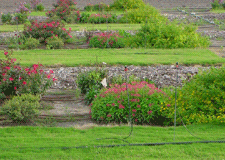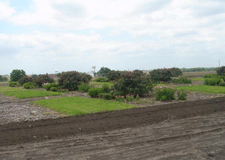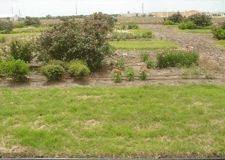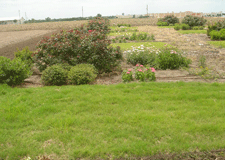Study 1: Use of dairy manure compost to establish newly constructed landscapes
Contact Information
Dr. John Sloan
jsloan@ag.tamu.edu
(972) 231-5362
Objective
Evaluate the effect of generous compost applications on the establishment and subsequent growth of typical urban landscape plants, including shrubs, annual and perennial flowers and turfgrass crops under full sun.
Treatments
| Treatment Number | Treatments | Replications |
|---|---|---|
| 1 | Untreated check | 4 replications |
| 2 | Compost (40 tons/acre) | 4 replications |
| 3 | Compost (80 tons/acre) | 4 replications |
| 4 | Compost (120 tons/acre) | 4 replications |
Procedure

Experimental design and plot layout for 0, 20, 40 and 80 tons/acre of dairy manure compost.
*APF=Annual and Perennial Flowers
Annual and Perennial Flower included in the study
- Crape Myrtle - Lagerstroemia indica
- Crazy Daisy - Leucanthemum x superbum
- Dwarf Buford Holly - Ilex cornuta
- Dwarf Yaupon Holly - Ilex vomitoria
- Egyptian Star Flower - Pentas lanceolata
- Knockout Rose - Rosa 'Knockout'
- New Gold Lantana - Lantana 'New Gold'
- Purple Coneflower - Echinacea purpurea
Soil samples were taken from Dallas plots prior to treatment and subsequently, on a yearly basis and documented in a field notebook. A 1-inch stainless steel probe will be used to sample the soils. Turfgrass color will be evaluated on a biweekly basis, and plots will be harvested on a weekly basis using a rotary mower. Vegetation samples will be taken from each turfgrass plot at the midpoint and end of the 2003 growing season as well as in the spring of 2004. The establishment and growth of annual and perennial flowers and shrub height and width will be monitored on a monthly basis.
Results
Characteristics of quality compost, the benefits of compost in urban landscapes and information on how to utilize dairy compost when establishing your own landscape is available in this presentation provided by Dallas personnel.
View the paper or the poster presented at the 2005 Southern NurseryMan Annual Meeting in Atlanta, GA on August 11-13, 2005.
Additional information and complete data analysis are included in the full report provided by Dallas personnel.
Using compost to establish turfgrass was also evaluated in this study. In subsequent years, half of each turfgrass plot received inorganic nitrogen fertilizer, while the other half received no supplemental nutrients. More detail on this comparison and an evaluation of the overall effects on turfgrass (including data analysis) are included in this report.
Photo documentation of plots can be seen below.







